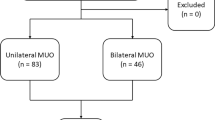Abstract
Objectives
Long-term ureteral stenting is used to ensure urinary drainage if a reconstructive approach or a release of an extrinsic obstruction is not possible. In this contribution, a long-term experience with a new full-length, metal indwelling stent is presented.
Methods
Fourteen patients with ureteral obstruction received full metal indwelling stents in 18 collecting systems (benign disease in 5 and malignant disease in 13). Stent placement was performed cystoscopically under fluoroscopic guidance. Follow-up was done every 3 months with ultrasonographic examination, creatinine levels, and a visual analog pain score.
Results
Eight stents were removed, whereas eight are still in situ. One patient without stent-related problems died because of progressive rectal cancer 9 months after bilateral stent insertion. Mean stent duration (8 stents still in situ) is 8.6 months, whereas mean stent duration for benign and malignant disease is 11.8 (median 13) and 7.3 (median 6) months, respectively (p < 0.05). All removed stents were extracted endoscopically without any problems and had no incrustation except two. Neither migration nor mechanical damage was observed.
Conclusion
This novel stent is easy to insert and remove. It is an option for patients in which a surgical reconstruction of the obstructed ureter is not possible. Stents have been developed further and are now available in various lengths. This might result in a reduction of problems associated with inadequate stent length and should increase patient comfort and stent durability.


Similar content being viewed by others
References
Docimo SG, Dewolf WC (1989) High failure rate of indwelling ureteral stents in patients with extrinsic obstruction: experience at 2 institutions. J Urol 142:277
Chung SY, Stein RJ, Landsittel D et al (2004) 15-year experience with the management of extrinsic ureteral obstruction with indwelling ureteral stents. J Urol 172:592
Liatsikos EN, Kagadis GC, Karnabatidis D et al (2007) Application of self-expandable metal stents for ureteroileal anastomotic strictures: long-term results. J Urol 178:169
Ku JH, Lee SW, Jeon HG, Kim HH, Oh SJ (2004) Percutaneous nephrostomy versus indwelling ureteral stents in the management of extrinsic ureteral obstruction in advanced malignancies: are there differences? Urology 64:5
Joshi HB, Adams S, Obadeyi OO, Rao PN (2001) Nephrostomy tube or ‘JJ’ ureteric stent in ureteric obstruction: assessment of patient perspectives using quality-of-life survey and utility analysis. Eur Urol 39:6
Lugmayr HF, Pauer W (1996) Wallstents for the treatment of extrinsic malignant ureteral obstruction: midterm results. Radiology 198:105
Pauer W, Lugmayr H (1992) Metallic Wallstents: a new therapy for extrinsic ureteral obstruction. J Urol 148:281
Klarskov P, Nordling J, Nielsen JB (2005) Experience with Memokath 051 ureteral stent. Scand J Urol Nephrol 39:169
Barbalias GA, Liatsikos EN, Kalogeropoulou C et al (2002) Externally coated ureteral metallic stents: an unfavorable clinical experience. Eur Urol 42:276
Thijssen AM, Millward SF, Mai KT (1994) Ureteral response to the placement of metallic stents: an animal model. J Urol 151:268
Hekimoglu B, Men S, Pinar A et al (1996) Urothelial hyperplasia complicating use of metal stents in malignant ureteral obstruction. Eur Radiol 6:675
Tunney MM, Keane PF, Jones DS et al (1996) Comparative assessment of ureteral stent biomaterial encrustation. Biomaterials 17:1541
Tunney MM, Bonner MC, Keane PF et al (1996) Development of a model for assessment of biomaterial encrustation in the upper urinary tract. Biomaterials 17:1025
Borin JF, Melamud O, Clayman RV (2006) Initial experience with full-length metal stent to relieve malignant ureteral obstruction. J Endourol 20:300
Conflict of interest statement
There is no conflict of interest.
Author information
Authors and Affiliations
Corresponding author
Rights and permissions
About this article
Cite this article
Nagele, U., Kuczyk, M.A., Horstmann, M. et al. Initial clinical experience with full-length metal ureteral stents for obstructive ureteral stenosis. World J Urol 26, 257–262 (2008). https://doi.org/10.1007/s00345-008-0245-4
Received:
Accepted:
Published:
Issue Date:
DOI: https://doi.org/10.1007/s00345-008-0245-4




